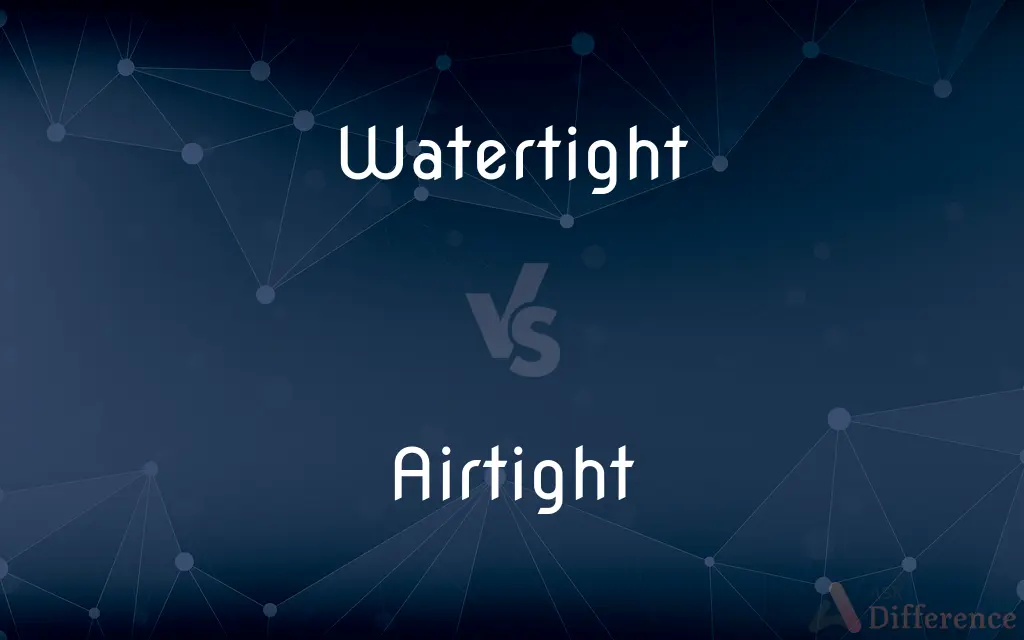Watertight vs. Airtight — What's the Difference?
By Maham Liaqat & Urooj Arif — Updated on March 17, 2024
Watertight seals prevent water entry, while airtight seals block air and gas.

Difference Between Watertight and Airtight
Table of Contents
ADVERTISEMENT
Key Differences
Watertight describes objects or materials designed to prevent water from entering or escaping, primarily focusing on liquid integrity. Whereas airtight refers to the ability to prevent the passage of air or gas, emphasizing gas tightness and preservation of contents from air exposure.
Watertight construction is crucial for vessels, underwater equipment, and structures facing liquid pressure, ensuring they remain dry and functional. On the other hand, airtight containers are essential for storing perishables, maintaining food quality, and preventing contamination or spoilage by blocking air exchange.
The testing standards for watertightness involve water immersion or pressure application to check for leaks, assessing an object's resistance to water penetration. Conversely, airtightness testing typically involves vacuum tests or gas leakage detection, focusing on sealing efficiency against air or gas ingress.
Watertight seals are often found in contexts where water exposure is a concern, like ship hulls, outdoor gear, and waterproof electronics, aiming to protect against moisture damage. Airtight seals, however, are more associated with food packaging, hermetic sealing in technology, and environments requiring controlled atmospheres, protecting against oxidation and gas leaks.
In terms of maintenance, watertight seals may require regular inspection for wear and degradation due to water exposure and pressure. Airtight seals, while also needing inspection, face challenges from changes in air pressure and potential gas permeation, demanding high-quality materials and precision in manufacturing.
ADVERTISEMENT
Comparison Chart
Primary function
Prevent water entry or escape
Prevent air or gas entry or escape
Usage contexts
Vessels, waterproof electronics, outdoor equipment
Food storage, hermetic seals, controlled atmospheres
Testing standards
Water immersion, pressure tests
Vacuum tests, gas leakage detection
Common challenges
Wear from water exposure, pressure effects
Gas permeation, changes in air pressure
Maintenance focus
Regular seal inspection for degradation
Seal integrity against air pressure and gas permeation
Compare with Definitions
Watertight
Designed to prevent water from entering or escaping.
The watertight doors on the ship prevented flooding during the storm.
Airtight
Not allowing the passage of air or gas.
The airtight compartment protects the sensitive instruments from atmospheric changes.
Watertight
Impervious to water under specific conditions.
The container's watertight seal kept the contents dry underwater.
Airtight
Sealed to prevent the entry or escape of air.
The airtight jar kept the coffee beans fresh for months.
Watertight
Constructed to withstand exposure to water.
The watertight watch remained functional even after diving.
Airtight
Hermetically sealed against air.
An airtight seal was necessary to preserve the medical samples.
Watertight
Having no openings for water penetration.
The watertight compartment ensured the survival of the electronics.
Airtight
Designed for maximum resistance to air penetration.
The airtight packaging ensured the chips remained crisp.
Watertight
Ensuring no leakage or seepage of water.
Their watertight argument left no room for rebuttal.
Airtight
Impermeable to air under any condition.
The airtight room maintained a stable environment for the experiments.
Watertight
So tightly made that water cannot enter or escape.
Airtight
Impermeable by air.
Watertight
Having no flaws or loopholes; impossible to fault, refute, or evade
A watertight alibi.
A watertight contract.
Airtight
Having no weak points; sound
An airtight excuse.
Watertight
So tightly made that water cannot enter or escape.
Airtight
Impermeable to air or other gases.
Watertight
(figurative) So devised or planned as to be impossible to defeat, evade or nullify.
A watertight contract; a watertight regulation
Airtight
(figuratively) Having no weak points or flaws.
We have an airtight argument they won’t be able to punch holes in.
Watertight
Having no leaks
Airtight
Highly reserved in some matter, particularly tight-lipped or tight-fisted.
Watertight
Not allowing water to pass in or out
Airtight
Having no weak points;
An airtight defense
An airtight argument
Watertight
Without flaws or loopholes;
An ironclad contract
A watertight alibi
A bulletproof argument
Airtight
Not allowing air or gas to pass in or out
Common Curiosities
Is watertightness the same as waterproofing?
Watertightness focuses on preventing water entry or escape, while waterproofing also includes resistance to water damage and permeation, making them similar but not identical concepts.
Are watertight seals necessary for outdoor equipment?
Yes, watertight seals are crucial for outdoor equipment to protect against moisture and ensure functionality in wet conditions.
Do airtight containers prevent odors?
Airtight containers can significantly reduce or prevent the escape of odors by blocking air exchange.
How do I test if something is watertight or airtight?
Testing for watertightness often involves water immersion or pressure tests, while airtightness can be checked using vacuum tests or detecting gas leaks.
What materials are used for watertight seals?
Materials like rubber, silicone, and other flexible, waterproof compounds are commonly used for watertight seals.
How do submarines maintain watertight integrity?
Submarines use watertight doors, hatches, and specialized seals to maintain integrity and prevent water entry.
Can airtight seals degrade over time?
Yes, airtight seals can degrade due to material wear, pressure changes, and environmental factors, requiring regular inspection.
Can a container be both watertight and airtight?
Yes, many containers are designed to be both watertight and airtight to provide maximum protection against liquid and gas penetration.
Can doors and windows be made watertight or airtight?
Yes, doors and windows can be designed to be watertight or airtight with proper seals and construction techniques to prevent water and air infiltration.
What's the difference between airtight and vacuum-sealed?
Airtight refers to sealing against air entry or escape, while vacuum-sealed involves removing air before sealing to create a vacuum environment.
Is there a standard rating for watertightness?
There are various standards and ratings for watertightness, including IP ratings, which specify the level of protection against water ingress.
How important is the material in determining the effectiveness of a watertight or airtight seal?
The material is crucial as it must have the right properties to resist water or air penetration, maintain flexibility, and withstand environmental conditions.
Are there any disadvantages to airtight buildings?
While airtight buildings improve energy efficiency, they may require ventilation systems to ensure adequate air quality.
Why is airtight packaging important for food?
Airtight packaging is important to prevent air exposure that can lead to food spoilage, contamination, and loss of freshness.
Can leaks develop in both watertight and airtight systems?
Yes, leaks can develop in both types of systems due to material failure, improper installation, or damage, highlighting the need for regular inspection and maintenance.
Share Your Discovery

Previous Comparison
Artifact vs. Relic
Next Comparison
Parasite vs. ParasolAuthor Spotlight
Written by
Maham LiaqatCo-written by
Urooj ArifUrooj is a skilled content writer at Ask Difference, known for her exceptional ability to simplify complex topics into engaging and informative content. With a passion for research and a flair for clear, concise writing, she consistently delivers articles that resonate with our diverse audience.
















































